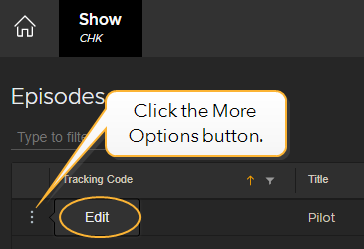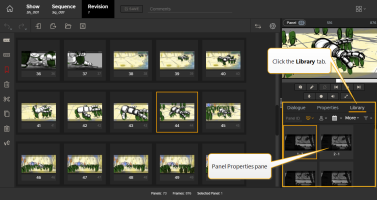Search is based on keyword.
Ex: "Procedures"
Do not search with natural language
Ex: "How do I write a new procedure?"
Flix for Production
Settings & Preferences
Before starting work on a production, it is a good idea to establish the settings for all Flix users first.
Studio Level Settings
To set preferences at the studio level:
| 1. | Navigate to File > Management Console > Studio Settings. |
| 2. | Edit the required preferences and enable their corresponding checkboxes under Enforce at Studio Level. |
This overrides the preferences set in the File > Preferences dialog. They appear as read only in the Flix Preferences dialog.
Show Level Settings
To set preferences at the show level:
| 1. | Navigate to the Shows level, click the More Options button of the required show and click Settings. |
This opens the Show Settings dialog for that specific show.
| 2. | Edit the required preferences and enable their corresponding checkboxes under Enforce at Show Level. |
This overrides the preferences set in the Flix Preferences dialog and at the studio level for that specific show.
Note: The Studio Settings can only be changed by admin users. The Show Settings can only be changed by the owner of the show or an admin user.
User Level Settings
To set preferences at the user level:
| 1. | Navigate to File > Preferences. |
| 2. | Edit the required preferences, for example set your audio output device. |

Setting Naming Conventions
Flix allows you to set naming conventions for file exports and publish directories using 'chips', which are placeholder shortcuts to metadata. They appear in the following format:
[date] [show_tracking_code] [show_title] [episode_tracking_code] [episode_title] [sequence_tracking_code] [sequence_title] [sequence_revision]
Note: Naming conventions can be enforced at the studio, show and user levels.
Example 1
To set a default naming convention for exported sequences:
| 1. | Go to File > Preferences > Exporting. |
| 2. | Click in the Filename Format field, then click on the chips at the bottom of the Preferences window to set your naming convention. The default is [show_tracking_code]-[sequence_tracking_code]-v[sequence_revision]. |
For example, if your show tracking code is 'THP', sequence tracking code is 'WED', sequence revision version is '25' and your default export path was /mnt/flix_publishes/ the full directory and exported file would be named /mnt/flix_publishes/THP-WED-v25.
All future exports follow this naming convention.
Example 2
To set a default naming convention for where Flix stores published files for Editorial:
| 1. | Go to File > Preferences > Third Party Apps > General |
| 2. | Click in the Publish Directory field, then click on the chips at the bottom of the Preferences window to set your naming convention. |
For example: Let's say your Publish Directory is set to /mnt/flix_publishes/[show_tracking_code]/[sequence_tracking_code]/[date]. If your show tracking code is 'THP', sequence tracking code is 'pilot' and the date is July 15 2020, the full directory would be /mnt/flix_publishes/THP/pilot/20-07-15/.
Note: The Publish Directory setting for both Windows and Mac is available at the studio or show level, for cases where multiple users might be on different operating systems.
Note: Flix will automatically create missing directories if they don't already exist.
Creating a Show
When you log in to Flix, you start at the Shows level. This is where you can open existing shows or create a new one.
The video below details how to set up a new show.
In the video:
• Setting up a new Show
• Setting up Flix with Photoshop
| 1. | Click the + New Show button to create a new show. |
| 2. | Fill in the Details. |
|
Details |
|
| Tracking Code |
This information is used to keep track of shows. Note: The Tracking Code is mandatory and must contain between 1 and 10 characters. |
| Title | Input the working title of your show here. |
| Description | A short paragraph description of your show, which can be viewed at the Shows level when you hover over the show's thumbnail. |
| Preview Image |
Adds a thumbnail image for your show, which can be viewed at the Shows level. Note: You can use .jpg, .gif, .png files. The maximum resolution is 800 x 800 pixels. |
| Configuration | |
| Frame Rate | Sets your show's frame rate. Choose from the common film and television frame rates up to 30fps. |
| Episodic |
Toggles whether your show contains episodes or not. This exposes a new option to set the Season number. |
| Aspect Ratio |
Sets your show's aspect ratio. Choose between common ratios such as 1.77:1 (16:9) and 2.39:1. |
| Permissions | |
| Groups | Specifies the groups of users who can access this show. For more information on creating groups, please refer to User Management. |
| 3. | Click Create. |
Your new show is added at the Shows level.
Creating Additional Seasons
A season of a show is stored at the Shows level and contains a number of episodes.
To create additional seasons:
| 1. | Using the breadcrumb, navigate to the Shows level and select the required season. The season information is displayed under the thumbnail of your show. |
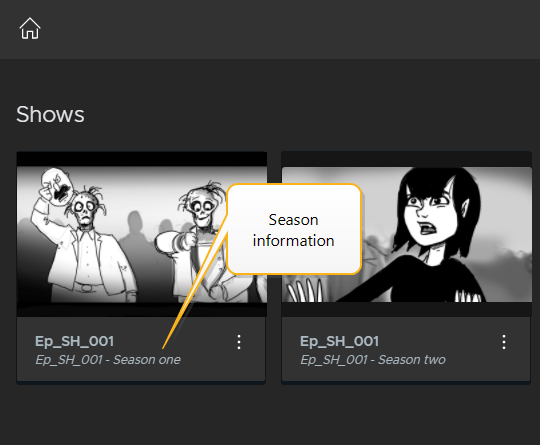
| 2. | Click the More Options button and select New Season. |
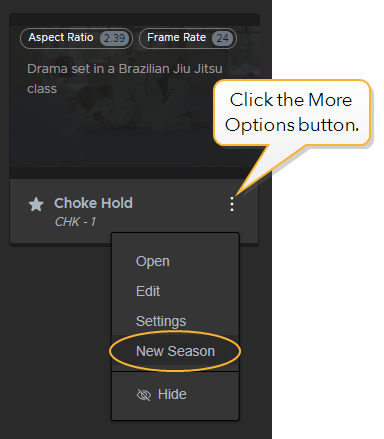
This opens the Create Show dialog. The details are pre-filled with the information you provided for the previous season.
| 3. | In the Details section, you can add a thumbnail for the new season. |
| 4. | In the Configuration section, you can change the Season information. You can also change any other information if required. Click Next. |
| 5. | In the Permissions section, update the Groups if needed, then click Create. |
Your new season is added at the Shows level.
Editing a Show
| 1. | Navigate to the Shows level in the breadcrumb, click the More Options button and select Edit. |
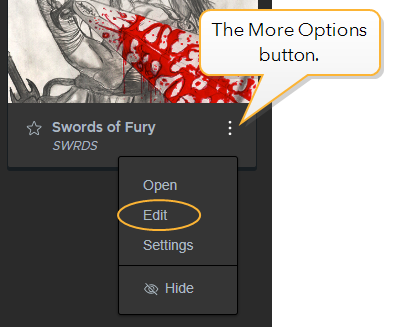
This opens the Edit Show dialog.
| 2. | Here you can edit the Details, Configuration and Permissions for your show. For example, use this menu to change the frame rate or access permissions for a user group. |
Warning: Changing the frame rate and/or aspect ratio of a show once story artists have begun work is not recommended, due to the fundamental impact on your production pipeline.
| 3. | Click Update to save your edits. |
Hiding a Show
Admin users can choose which shows are displayed at the Shows level.
To hide an existing show:
| 1. | Navigate to the Shows level in the breadcrumb, click the More Options button and select Hide. |

The show is invisible at the Shows level.
Note: Admin users can toggle the Show hidden button ON to display all hidden shows. This button is set to OFF by default.
| 2. | To unhide the show, click on the More Options button and select Unhide. |
Starring a Show
If you have access to lots of shows, it can be useful to mark specific ones so they appear at the top of lists. Flix allows users to star shows and remembers this setting on a per-user basis, meaning if you mark a show as starred it will only appear starred for you.
To star a show:
| 1. | Navigate to the Shows level in the breadcrumb. |
| 2. | Click the |
The show is now marked important and appears at the top of your show list.
Creating an Episode
Episodes are shown at the first level down from Shows in the breadcrumb.
| 1. | In the breadcrumb, navigate to the Shows level and open your show. |
Note: If your show does not contain any episodes, a menu for creating a new episode opens here.
| 2. | Click + New Episode. |
The New Episode menu opens.
| Tracking Code |
This information is used to keep track of shows. Note: The Tracking Code is mandatory and must contain between 1 and 20 characters. |
| Title | Use this to name your episode. For example, "The Big Wedding". |
| Episode Number |
Enter the episode number. For example, a common naming convention for is 101, 102 etc. |
| Description | Here you can write a brief synopsis of the episode. |
| Comments | Enter additional comments here. These can be viewed at the Episodes level in the Comments column. |
| 3. | Click Create. |
You can continue creating additional episodes in this window. Click Close when finished.
Your new episode/s are listed at the Episodes level.
Note: Open an episode and click + New Sequence to create sequences, then follow the steps above.
Editing an Episode
| 1. | Using the breadcrumb, navigate to the Episodes level and click the More Options button, then Select Edit. |
This opens the Edit Episode dialog.
| 2. | Enter the new information for your episode. |
| 3. | Click Update to save your edits. |
Creating a Sequence
Sequences are shown at the first level down from Shows in the breadcrumb.
| 1. | In the breadcrumb, navigate to the Shows level and open your show. |
Note: If your show does not contain any sequences, a menu for creating a new sequence opens here.
| 2. | Click + New Sequence. |
The New Sequence menu opens.
| Tracking Code |
This information is used to keep track of shows. Note: The Tracking Code is mandatory and must contain between 1 and 20 characters. |
| Title | Use this to name your sequence or episode. For example, "Wedding montage". |
| Act | Specifies the act of the story in which your sequence occurs. |
| Comments | This description can be viewed at the Sequences level in the Comments column. |
| 3. | Click Create. |
You can continue creating additional sequences in this window. Click Close when finished.
Your new sequences or episodes are listed at the Sequences level.
Editing a Sequence
| 1. | Using the breadcrumb, navigate to the Sequences level and click the More Options button, then Select Edit. |

This opens the Edit Sequence dialog.
| 2. | Enter the new information for your sequence. |
| 3. | Click Update to save your edits. |
Hiding a Sequence
You may want to hide a sequence from your list if it has been cut from the story or shelved for later use. To do this:
| 1. | Navigate to the Sequences level, click the More Options button of the required sequence and select Edit. |

This opens the Edit Sequence menu.
| 2. | Click the OOP (Out Of Picture) toggle button. |
The sequence is now hidden from the list.
| 3. | Click Update to save this setting. |
At the Sequences level, toggle the Show OOP button to reveal hidden sequences.
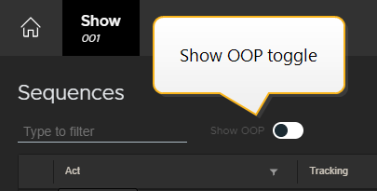
Using the Panel Browser
The Flix Panel Browser is the workspace in which you'll spend most of your time. The video below gives a quick overview of how the Panel Browser works.
In the video:
• Importing panels. For more information, please refer to Flix for Story.
• Each panel displays a unique Panel ID and Index, or position number. If the panel has been updated, a new version is created and numbered.

Note: You can swap the position of each panel's unique ID with its Index number. See Swap Panel ID with Index in Preferences.
• Move panels around by selecting one or more, and dragging them where you want to place them. Hold Shift and click to select a sequence of panels, or Ctrl/Cmd and click to select individual panels.
• Remove panels from your current edit by clicking the Trashcan icon in the Edit toolbar.
• Re-use panels by using the Copy and Paste buttons in the Edit toolbar. This creates new panels re-using the same panel, timing, and dialogue.
• Adding and versioning dialogue.
Keeping Edits Organized
To keep your edits organized, you can filter the Comments column at the sequence level by keyword.
For example:
| 1. | Go to the Sequence level of your show. |
| 2. | Find a sequence revision at random in the list, then click on the more options button and select Edit. |
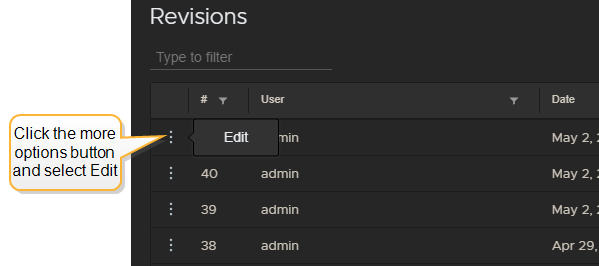
| 3. | Type in the comment "Use for screening" and click Save. |
| 4. | Above the Revisions list, type the word "screening" into the filter. |
Only sequence revisions with comments containing that word are now displayed. This is a handy way of organizing a long list of sequence revisions.
Tip: If you are on the Panel Browser and make any change to a revision, such as adding dialogue or annotations, you can also add a comment and after saving it will be filterable at the Sequence Level.
The User, Date and Comments columns each have their own filters, so you can narrow down your search results even further. See below.
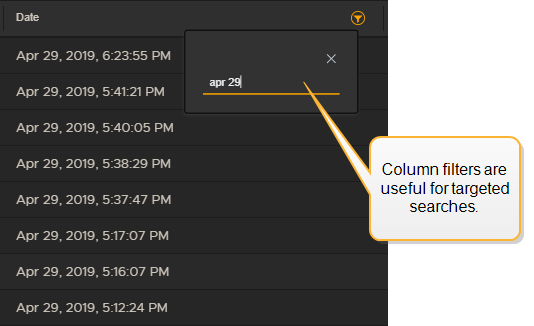
Highlighting Panels
To highlight panels in your sequence:
| 1. | In your edit (sequence revision), select one or more panels. |
| 2. | In the left toolbar, click and hold the Highlight button and click on a color. |
This selected panels are tagged with the chosen color.

To remove highlights:
| 1. | Select the highlighted panels. |
| 2. | In the left toolbar, click the Highlight button. |
This removes the highlight from the selection.
Comparing Edits
| 1. | In your currently loaded edit, in the main toolbar, click the Compare Tool. |
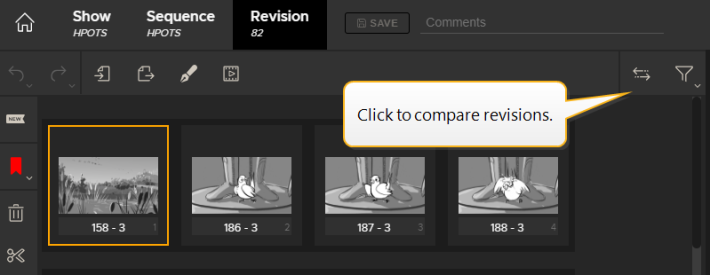
This opens the Compare revision dialog.
| 2. | Select the revision to compare your current revision with and click Compare. |
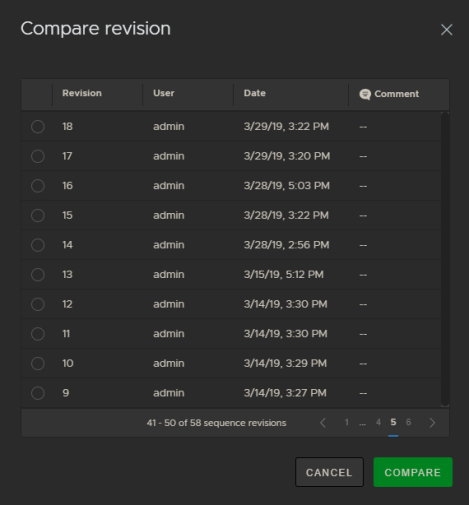
Panels that have been added display a 

Note: 
| 3. | Click the Compare Tool again to stop displaying the icons. |
Locating Panels in the Library
You can use the Library to find old panels:
| 1. | In the Panel Properties pane, select the Library tab. |
| 2. | Click the Filter by Sequence button and select a specific sequence or episode. |
This displays the panels created in that particular sequence or episode.
| 3. | You can also use different filters to narrow your search down: |
• Enter the Panel ID of the panel you are looking for.
• Click the Filter by username button to display panels created by a specific artist.
• Click the Filter by date range button to display panels created on a specific date or between two specific dates.
• Click the More button to display the Master Images and/or all revisions as well.
| 4. | When you found the required panels, select them and drag them in your current edit (sequence revision). |
If a panel already exists in the current edit, Flix creates a new instance of that panel rather than using the same one.
Note: Click the Reset Filters button to clear all applied filters.

Copying Panels from Another Edit
If you'd like to copy panels from another edit into your current one, you can either open another Flix window and copy the panels to your current edit or drag them from the Library.
Note: Copying panels from another edit retains the dialogue and duration from the original edit, unlike copying panels from the Library.
Method 1 - Using Another Flix Window
| 1. | Navigate to File > New Window. |
This opens a second Flix window.
| 2. | In the second Flix window, navigate to the required edit and select the panel(s) you want. |
| 3. | Click the |
| 4. | In the original Flix window, click the |
The panel(s) are copied after the selected panel.
Method 2 - Using the Library
| 1. | In the Panel Properties pane, select the Library tab. |
| 2. | Click the Filter by Sequence button and select a specific sequence or episode. |
This displays the panels created in that particular sequence or episode.
| 3. | You can also use different filters to narrow your search down, see the previous section, Locating Panels in the Library . |
| 4. | Drag the required panels into the edit (sequence revision). |
Exporting an Edit as a QuickTime
Tip: Before exporting, navigate to File > Preferences > Exporting to set the directory path and the filename structure for your exported files. See Flix Preferences.
| 1. | Ensure your edit is saved to include all changes in the panels to export. |
| 2. | Select the panels you want to export. Don't make any specific selection if you want to export the whole edit. |
| 3. | In the main toolbar, click the Export from Flix button. |
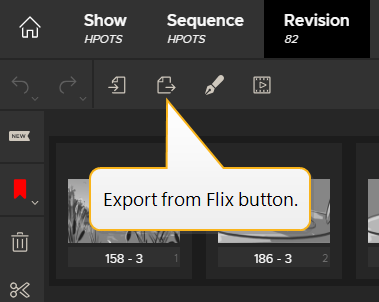
This opens the Export dialog.
| 4. | Select whether you want to export All panels or Selected panels, if you have selected panels in your edit. |
| 5. | Select QuickTime. |
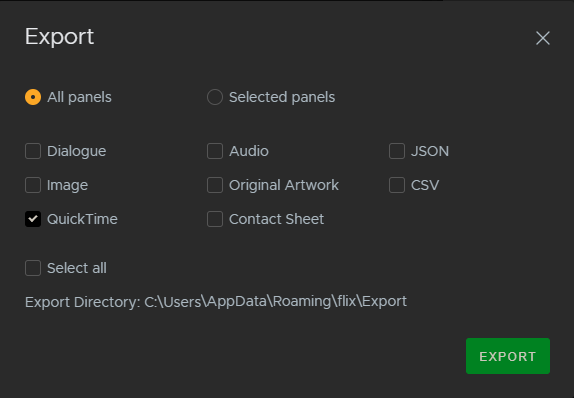
| 6. | Click Export. |
A file browser opens in the directory containing your exported QuickTime file.
| 7. | Click the X button to close the Export dialog. |
Exporting Panels out of Flix
Tip: Before exporting, navigate to File > Preferences > Exporting to set the directory path and the filename structure for your exported files. See Flix Preferences.
| 1. | Ensure your edit is saved to include all changes in the panels to export. |
| 2. | Select the panels you want to export. Don't make any specific selection if you want to export the whole edit. |
| 3. | In the main toolbar, click the Export from Flix button. |

This opens the Export dialog.
| 4. | Select whether you want to export All panels or Selected panels, if you have selected panels. |
| 5. | Select Original Artwork to export the original files imported into Flix and/or Images to export the thumbnails visible in Flix. |
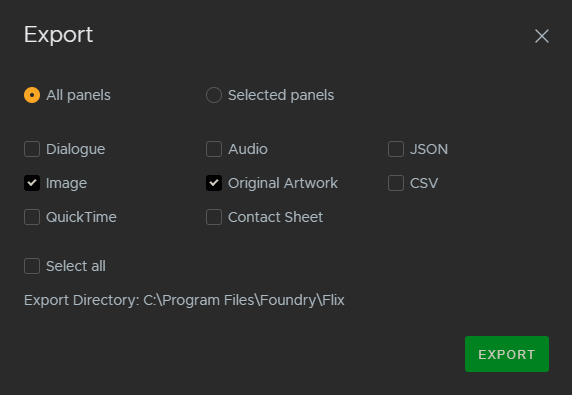
| 6. | Click Export. |
A file browser opens in the directory containing your exported panels.
| 7. | Click the X button to close the Export dialog. |
Sorry you didn't find this helpful
Why wasn't this helpful? (check all that apply)
Thanks for your feedback.
If you can't find what you're looking for or you have a workflow question, please try Foundry Support.
If you have any thoughts on how we can improve our learning content, please email the Documentation team using the button below.
Thanks for taking time to give us feedback.
